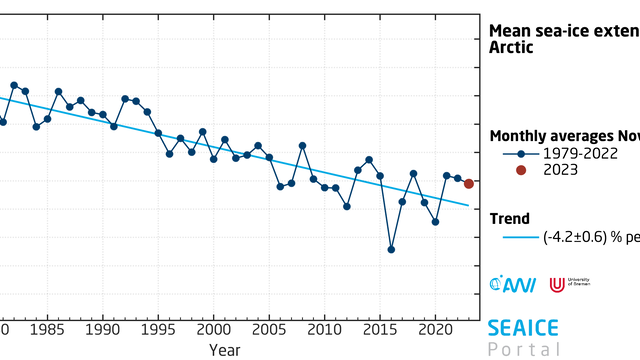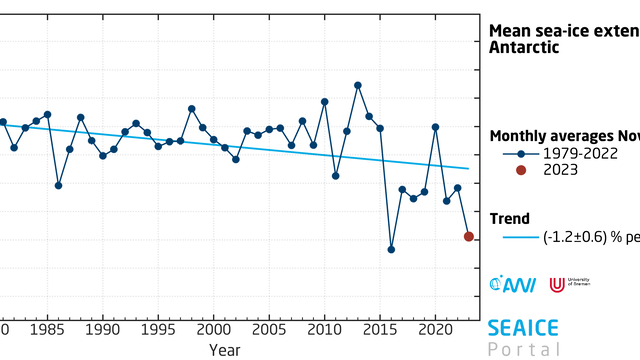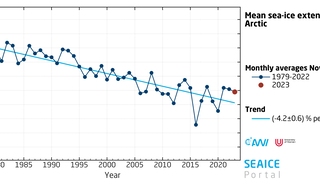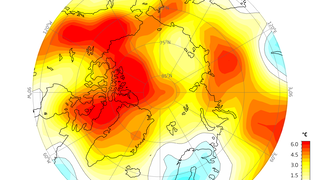The sea ice in the polar regions is an important indicator for global climate change, as the two regions are essentially our planet’s early warning system. The loss of sea ice is a direct effect of global warming, which is three to four times as intense in the Arctic as the global mean. In turn, the effects of dwindling ice in the Arctic impact the global climate system. In this regard, those of us living in Europe are directly affected by the changed atmospheric circulation. In addition, this year a trend seen in the Antarctic since 2016 is especially pronounced, as the record sea-ice extent minima in eight of the first eleven months of the year show. For the first time since the beginning of continuous satellite observation of the Antarctic ice cover, this dramatic ice loss has persisted for nearly the entire year.
Through the web relaunch on 24 January 2023, the SEA ICE PORTAL was fundamentally overhauled and given a more modern, up-to-date face, to help reflect the growing importance of the climate component sea ice. Thanks to the update, we can share science-based findings on climate change and its impacts in the polar regions in even clearer and more diverse formats. Even if the road to a sustainable, climate-aware future is a hard and complex one, if we want to keep the effects of climate warming manageable, we have no choice but to reach this goal by mid-century. In this regard, science-based, factual knowledge is indispensable – and that’s precisely what we offer at the SEA ICE PORTAL.
We wish you a peaceful and joyful 2024 and thank you for your continuing interest in the SEA ICE PORTAL. We look forward to sharing the latest, reliable information on the polar regions, which are so important for us all, with you in the year to come.
Your SEA ICE PORTAL Team
Developments in the Arctic
Since reaching the Arctic minimum on 15 September 2023, the ice has been steadily growing. However, the sea-ice extent grew only slowly at first, resulting in the sixth-lowest mean value for September since the beginning of passive microwave satellite observation in 1979. Afterwards, the sea-ice extent developed roughly in keeping with the minima for the years 1981 – 2010 (Fig. 1). The monthly mean for November was the ninth-lowest since 1979 and was ca. 879,000 km² below the long-term mean for the years 1979 – 2023 (Fig. 2).
Air temperatures over the Arctic Ocean at 925 hPa pressure altitude were very similar to those seen in October and were primarily above-average, especially in and near the Canadian Arctic Archipelago and in Northwest and Eastern Siberia, where temperatures 4 to 5 degrees Celsius above the long-term mean were recorded. From the north and northeast of Greenland to the polar region, temperatures were 2 to 4 degrees Celsius above the long-term mean for the years 1971 – 2000, a phenomenon that stretched to the Laptev and Kara Seas, and to the southern reaches of the Beaufort Sea. Over the East Siberian Sea, temperatures were near the long-term mean. Below-average temperatures of up to two degrees Celsius below the long-term mean could only be found in Scandinavia.
It remains to be seen how the Arctic sea ice will develop in the coming months.
Developments in the Antarctic
The year 2023 has been characterised by unusually low sea-ice extents in Antarctic waters. After the record values seen in recent months, the November extent was the second-lowest among the long-term observations (Fig. 4). The mean sea-ice extent in November was 14.06 million km², placing it just 1.6 percent above the lowest monthly mean value for November, from 2016 (13.82 million km²).
In November, the sea-ice extent was consistently low in the western Weddell Sea, the Cosmonauts Sea, the western Ross Sea and the Bellingshausen Sea, although slightly higher than in 2016. In the Amundsen Sea, the eastern Ross Sea and from the eastern Weddell Sea to the Riiser-Larsen Sea, the sea-ice extent was lower than in 2016, the year with the lowest November sea-ice extent to date (Fig. 5).
Once again, this was due to large regions with atmospheric temperatures above the long-term mean (ca. 1 to 3 degrees Celsius) and to warm water masses in the ocean’s upper mixed layer, which can delay ice formation.
“After the alarming, extremely low winter sea-ice extent in the Southern Ocean, the extent seems to have stabilised for the time being. If we take a look at the pan-Antarctic sea-ice extent, it’s close to the range for 2016, the year with the lowest-ever extent in November. But if we explicitly focus on the regional anomalies, in the Weddell and Ross Seas we can still see pronounced negative anomalies compared to the long-term mean. These trends were in the spotlight at the Cryosphere Pavilion at the UN Climate Change Conference in Dubai (COP28), where they were extensively discussed as an example of how the Antarctic sea ice is now changing, too, showing how vital it is to reach the 1.5°C target set in the Paris Agreement,” adds Dr Stefanie Arndt, a sea-ice physicist at the AWI.
The Southern Summer, which has now begun, will show whether or not the trend of extremely low Antarctic sea-ice extents continues.
Contact
Questions?
Write us an
E-Mail or use the contact form.
Graphics











